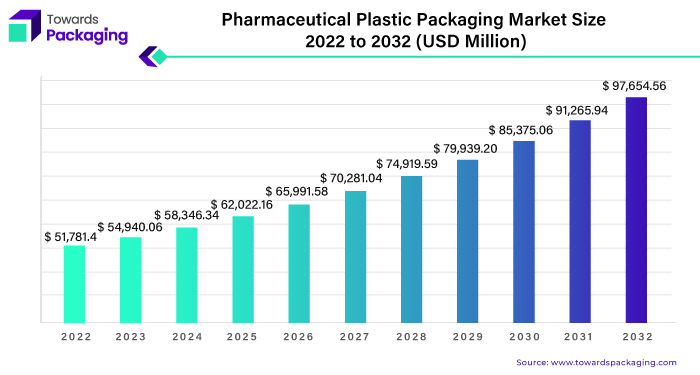Pharmaceutical Plastic Packaging Market Growth
The global pharmaceutical plastic packaging market is expected to witness significant growth, rising from $51.78 billion in 2022 to an estimated $97.65 billion by 2032. This represents a compound annual growth rate (CAGR) of 6.6% during the forecast period from 2023 to 2032.

Download Statistical Data: https://www.towardspackaging.com/download-statistics/5106
Highlights from the Pharmaceutical Plastic Packaging Market
The global pharmaceutical plastic packaging market, valued at $51.78 billion in 2022, is expected to grow to $97.65 billion by 2032, driven by a steady CAGR of 6.6% between 2023 and 2032.
Key trends shaping the market include:
- North America’s leadership in advanced pharmaceutical packaging solutions.
- Rapid growth in Asia-Pacific economies as they adopt plastic packaging for expanding pharmaceutical industries.
- The pivotal role of polyethylene (PE) in offering flexible and reliable packaging solutions.
Why Packaging Matters
Pharmaceutical plastic packaging is vital for protecting medications from contamination, damage, and counterfeiting while extending shelf life. Beyond safety, it ensures compliance with stringent international regulations, making it a cornerstone of the global pharmaceutical supply chain.
The market encompasses a range of products, including plastic bottles, parenteral containers, and blister packs, driven by advancements in research, the rise of generic drugs, and the development of innovative materials. Packaging innovations now include specialty bags, closures, labels, and more, with increased outsourcing to contract packagers further fueling growth.
Shifting Trends in Drug Delivery
Oral medications, including tablets, capsules, powders, and liquids, dominate the market, accounting for 51% of pharmaceutical consumption. However, alternative delivery methods are gaining traction, with parenteral and intravenous options at 29%, inhalation at 17%, and transdermal methods at 3%.
Challenges Ahead
Despite the industry’s growth, challenges such as rising packaging costs, strict regulatory requirements, and anti-counterfeiting measures continue to impact the market. Balancing compliance, innovation, and affordability remains a critical task for manufacturers.
Sustainability in Focus
Transitioning to recyclable pharmaceutical packaging faces hurdles such as:
- Ensuring patient safety with recycled materials.
- Meeting stringent regulatory standards from organizations like the FDA and EMA.
- Managing costs related to collection, sorting, and reprocessing of materials.
- Assessing the environmental benefits versus the energy costs of recycling.
Collaboration between regulatory bodies, manufacturers, and recycling industries is essential to advancing eco-friendly packaging solutions without compromising safety.
Recent Industry Developments
- In January 2023, TricorBraun acquired Australia-based Plas-Pak WA to strengthen its plastic packaging portfolio.
- In March 2023, ALPLA Group entered a joint venture with Indian Pharma to manufacture pharmaceutical bottles and closures.
- In August 2023, DuPont completed its acquisition of Spectrum Plastics Group, expanding its medical device packaging capabilities.
- In October 2023, Sumitomo Bakelite acquired 90% of Asahi Kasei Pax’s film division to enhance its pharmaceutical packaging technology.
- In December 2022, Shriji Polymers India acquired a majority stake in Parekhplast India, furthering its reach in rigid pharmaceutical packaging.
Buy Premium Global Insight: https://www.towardspackaging.com/price/5106
Get the latest insights on packaging industry segmentation with our Annual Membership – https://www.towardspackaging.com/get-an-annual-membership
If you have any questions, please feel free to contact us at sales@towardspackaging.com
Browse our Brand-New Journal:
https://www.towardshealthcare.com
https://www.towardsautomotive.com
For Latest Update Follow Us: https://www.linkedin.com/company/towards-packaging/
Get Our Freshly Printed Chronicle: https://www.packagingwebwire.com/